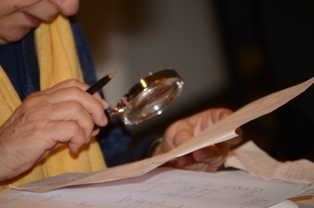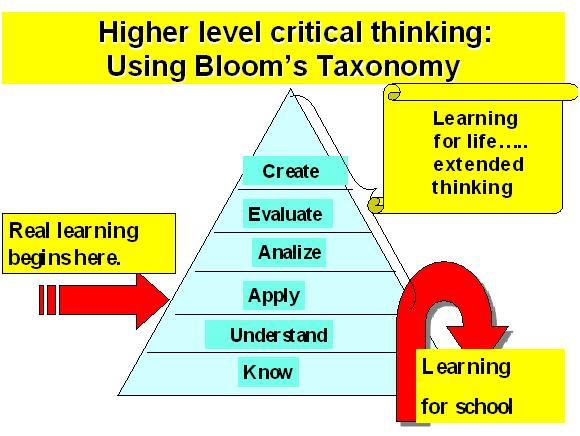Use of VERBS in your activities (Bloom is gone, but not forgotten!)
Have you thought about how to make your classes more inquiry-based, more challenging, leading students to critical thinking? Don’t forget the power of using Bloom’s taxonomy when planning your lessons.
Simply by changing the verb in your instructions to your students, can raise or lower the critical thinking expectations. It’s a much lower mental task to ask students to «List ten fruits/vegetables», than to ask them to «Create a week’s healthy menu using ten fruits/vegetables.».
Dr. Benjamin Bloom, in 1956, as Editor of «Effective School Research», designed a graphic showing six levels at which humans develop cognitively. The two lowest levels (know and comprehend) are basic to all learning, but depend, mainly, on memorization and rote practice, what Bloom called, «Learning for School».
BELOW: Updated chart of Bloom’s Taxonomy of Cognitive Thought
EXPLANATION: From the lowest level of cognitive thought to the highest:
KNOW:
Facts that are memorized, drilled, and remembered because much practice.
Examples: reciting the alphabet, counting, a formula: A = H x W
UNDERSTAND / COMPREHEND:
Understanding what was memorized….Counting to 10 is to know, memorization.
Recognizing the number eight when 8 fingers are shown, is comprehension.
APPLY:
Using the material learned (knowledge + comprehension) by solving problems, writing a sentence or paragraph, illustrating, etc.
ANALYZE:
Taking something apart to analyze it: a story, a character, a math problem, a news event, separating things into categories, etc.
EVALUATE / ASSESS:
Making a judgment: the best story read, the best character, the most complete paragraph, the most interesting movie, etc.
CREATE / SYNTHESIZE:
Putting things together: combining words to make sentences or a paragraph; seeing patterns in things, creating something new from older things, etc.
========================================
To enhance your lessons, to challenge your students, to raise the critical thinking levels of your students, simply change the verbs in your lessons or instructions, and automatically your students’ levels of performance will change in response to the verb you used.
Verbs at the level of «KNOW» will not elicit or need such a high level of cognition to perform as verbs on the list of ANALYZE» or «CREATE».
TEACHERS:
Vary the verbs in lessons to challenge your students and to build critical thinking experiences. See below.
| 1.Know | 2. Understand | 3. Apply |
| list name identify show define recognize recall orally statepoint at… |
summarize explain translateinterpret describe compare paraphrase differentiate demonstrate visualize find more information about restate |
solve illustrate calculate use interpret relate manipulate apply classify modify put into practice |
| 4. Analize | 5. Evaluate | 6. Create |
| analyze organize deduce choose contrast compare distinguish |
choose/why? estimate judge defend criticize justifyprove debate evaluate |
design hypothesize support schematize write report discuss plan devise create |
You can put your ideas into actions, teachers, by thinking of activities to support the academic content you’re teaching. Then, use verbs at various levels of the taxonomy. Over time, use all six levels so that your students are exposed to different levels of cognitive thought. This will enhance and develop their critical thinking ability.
Here, below, are some sample question-stems and activities for each of the six levels of Bloom’s Taxonomy.
KNOW:
Facts that are memorized, drilled, and remembered because much practice.
Examples: reciting the alphabet, counting, a formula: A = H x W
SAMPLE QUESTION-STEMS
- What happened after…..?
- How many…..?
- Who was it that….?
- Can you name the …?
- Describe what happened at…
- Who spoke to…?
- Can you tell me why..?
- Find the meaning of…?
- What is …? Which is true or false…?
POTENTIAL ACTIVITIES
- List the story’s main events
- Make a timeline of events.
- Make a facts chart.
- List any pieces of information you can remember.
- Recite a poem.
- List all the animals in the story.
- Make a chart showing…
- Make an acrostic.
UNDERSTAND / COMPREHEND:
Understanding what was memorized….Counting to 10 is to know, memorization.
Recognizing the number eight when 8 fingers are shown, is comprehension.
SAMPLE QUESTION-STEMS
- Can you write in your own words…?
- Write a brief outline…
- What do you think could have happened next…?
- Who do you think…?
- What was the main idea?
- Who was the main character?
- Can you distinguish between…?
- What differences exist between…?
- Can you provide an example of what you mean by…?
- Can you provide a definition for…?
POTENTIAL ACTIVITIES
- Cut out or draw pictures to show a particular event.
- Illustrate the main idea.
- Make a cartoon strip showing the sequence of events.
- Write and perform a play based on the story.
- Make a coloring book.
- Retell the story in your own words.
- Paint a picture of some aspect of the story you like.
- Write a summary of the events.
- Prepare a flow chart to illustrate the sequence of events.
APPLY:
Using the material learned (knowledge + comprehension) by solving problems, writing a sentence or paragraph, illustrating, etc.
SAMPLE QUESTION-STEMS
- Do you know another instance where…?
- Could this have happened in…?
- Can you group by characteristics such as…?
- What factors would you change if…?
- From the information given, develop a set of instruction about?
- Would this information be useful if you had a….?
POTENTIAL ACTIVITIES
- Construct a model to demonstrate how it will work.
- Make a diorama to illustrate an important event.
- Compose a book about…
- Make a scrapbook about the areas of study.
- Make a paper-mache map showing information about an event.
- Make a puzzle game using ideas from the study area.
- Make a clay model of…
- Paint a mural.
- Design a market strategy for your product.
- Design an ethnic costume.
ANALYZE:
Taking something apart to analyze it: a story, a character, a math problem, a news event, separating things into categories, etc.
SAMPLE QUESTION-STEMS
- Which event could not have happened if…?
- If…happened, what might the ending have been?
- How was this similar to…?
- What do you see as other possible outcomes?
- Why did …. changes occur?
- Can you compare your…with that presented in…?
- What must have happened when…?
- How is ……similar to….?
- What are some of the problems of…?
- Can you distinguish between…?
- What was the turning point in the story?
- What was the problem with….?
- What were some of the motives behind….?
POTENTIAL ACTIVITIES
- Design a questionnaire to gather information.
- Make a flow chart to show critical stages.
- Write a commercial for a new/familiar product.
- Review a work of art in terms of form, color, and texture.
- Construct a graph to illustrate selected information.
- Construct a jigsaw puzzle.
- Analyze a family tree showing relationships.
- Write a biography about a person being studied.
- Arrange a party and record/list the steps you took.
EVALUATE / ASSESS:
Making a judgment: the best story read, the best character, the most complete paragraph, the most interesting movie, etc.
SAMPLE QUESTION-STEMS
- Is there a better solution to…?
- Judge the value of…
- Defend your position about…
- Do you think…is a good or bad thing? Explain.
- How would you have handled…?
- What changes to…would you recommend? Why?
- Do you believe…?
- Are you a ….person? Why?
- How would you feel if…
- How effective are…?
- What do you think about…?
POTENTIAL ACTIVITIES
- Prepare a list of criteria to judge a …show. Indicate priority and ratings.
- Conduct a debate about an area of special interest.
- Make a booklet about 5 rules you value
- Form a panel to discuss a topic. State criteria
- Write a letter to…advising changes needed.
- Prepare arguments to present your view about….
CREATE / SYNTHESIZE:
Putting things together: combining words to make sentences or a paragraph; seeing patterns in things, creating something new from older things, etc.
SAMPLE QUESTION-STEMS
- Can you design a ….to….?
- What is the possible solution to…?
- What would happen if…?
- If you had access to all resources, how would you deal with…”
- How would you devise your own way to….?
- How many ways can you…?
- Can you create new and unusual uses for …?
- Can you develop a proposal that would…?
- How would you compose a song about…?
- Can you write a new recipe for a tasty dish?
POTENTIAL ACTIVITIES
- Invent a machine to do a specific task.
- Design a building.
- Create a new product. Give it a name and plan a marketing campaign.
- Write about your feelings in relation to….
- Write a TV show, play puppet show, role play, song, or pantomime about…
- Design a record, book, or magazine cover for …
- Devise a way to…
- Create a language code.
- Sell an idea to a billionaire.
- Compose a rhythm or put new words to a known melody.
============================================
Now you’re prepared to put your IDEAS INTO ACTIONS.
=============================================
_________________________________

